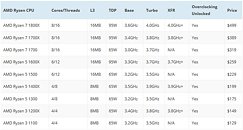Sunday, February 12th 2017

AMD Ryzen XFR Frequencies Revealed
AMD's upcoming Ryzen processors are "unlocked," in that they feature unlocked base-clock multipliers that let you easily overclock them; yet a few of its variants feature a brand extension "X." As our older article details, the "X" refers to availability of the XFR (extended frequency range) feature. Think of it as a second stage boost that rewards good CPU cooling with higher CPU clocks set automatically. The Ryzen R7-1800X, R7-1700X, R5-1600X, R5-1400X, and R3-1200X feature this.
The R7-1800X features clock speeds of 3.60 GHz, with TurboCore frequencies of 4.00 GHz and XFR ranging beyond 4.00 GHz. That of the R7-1700X is set beyond 3.80 GHz, and the R7-1600X beyond 3.70 GHz, R5-1400X beyond 3.90 GHz, and the R3-1200X beyond 3.80 GHz. There are no fixed values as to how much higher these frequencies will go, probably because AMD doesn't want to advertise clock speed figures consumers hold it to account for. The TurboCore frequencies, on the other hand, are achievable on even the included stock cooling solutions, or coolers that meet the TDP ratings of these chips.
Source:
WCCFTech
The R7-1800X features clock speeds of 3.60 GHz, with TurboCore frequencies of 4.00 GHz and XFR ranging beyond 4.00 GHz. That of the R7-1700X is set beyond 3.80 GHz, and the R7-1600X beyond 3.70 GHz, R5-1400X beyond 3.90 GHz, and the R3-1200X beyond 3.80 GHz. There are no fixed values as to how much higher these frequencies will go, probably because AMD doesn't want to advertise clock speed figures consumers hold it to account for. The TurboCore frequencies, on the other hand, are achievable on even the included stock cooling solutions, or coolers that meet the TDP ratings of these chips.

74 Comments on AMD Ryzen XFR Frequencies Revealed
Just. Release. Damn. Chip already !
Anyway. On to the thread topic.....
Im saving for a setup, its been a long time without a new computer for me, and Im buying one as long as the numbers meet the expectation. If not I am going Intel. Whatever is best for the buck in performance.
As far as the XFR and TDP, this is the same company that released overvolted 480's that got too warm to maintain stock clocks. Threre has to be a max voltage put into the chip for the process used, and I'm sure that will be the deciding factor in how high of a clock any chip can achieve, be it 5Ghz or not. They might die test and program each chip for its maximum XFR range and voltage. Either way its going to be interesting to see what the chip is capable of on its own VS manual tweaking.
The temperatures are with the supplied coolers, not with third party cooling.
To be honest; Im pretty sure you'll manage WHEN they actually officially release these details other than a clusterf*** of leaks fabrications and segments of info. TO me at least for now it seems more easily understood than intels with their pentium and celeron brand + overlapping i3-i5-i7 segments on laptop market. Lets wait and be NOT confused :)
"+"
Some newer direct injection vehicles use a similar technique to gain as much power and fuel economy based on the Octane ratio of the fuel. For example some DIT engines will advance timing until knock is heard. Once knock is heard it either pulls timing or stops advancing timing. After a while the vehicle learns the optimum timing. If you get a bad tank of gas the car will recognize this and begin to pull timing until knock is no longer detected.
It would be sweet if the new AMD cpu is constantly trying to up the frequency until it finds an optimum speed and then adjusts when temps get too hot(dirty heat sink)
I think it would be cool too, even with dirty heat-sink it may allow short burst high speed for single threaded applications.
</off topic>
The Canadian $$$$ amount for all 8-Core Ryzen CPU's are Expensive. Really Expensive. lol, I hate that in the USA, its a lot cheaper for stuff.